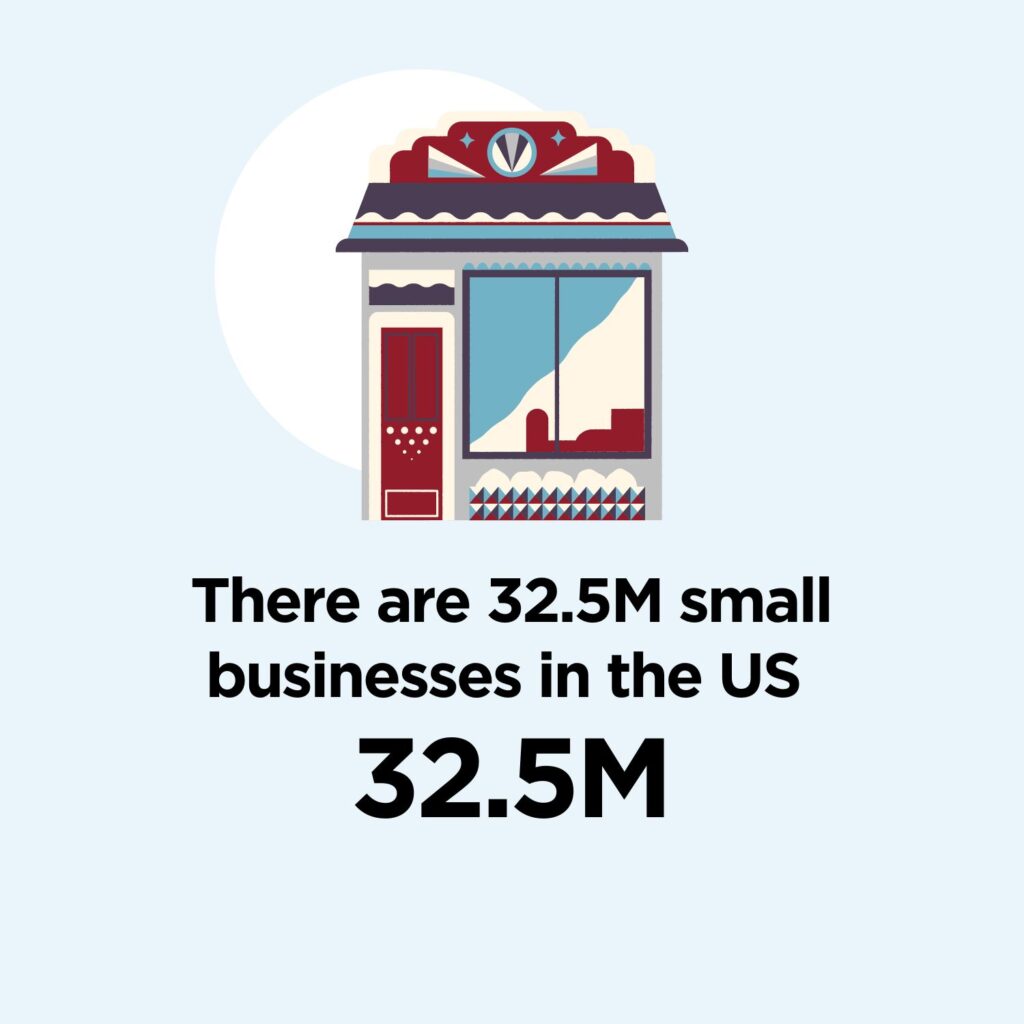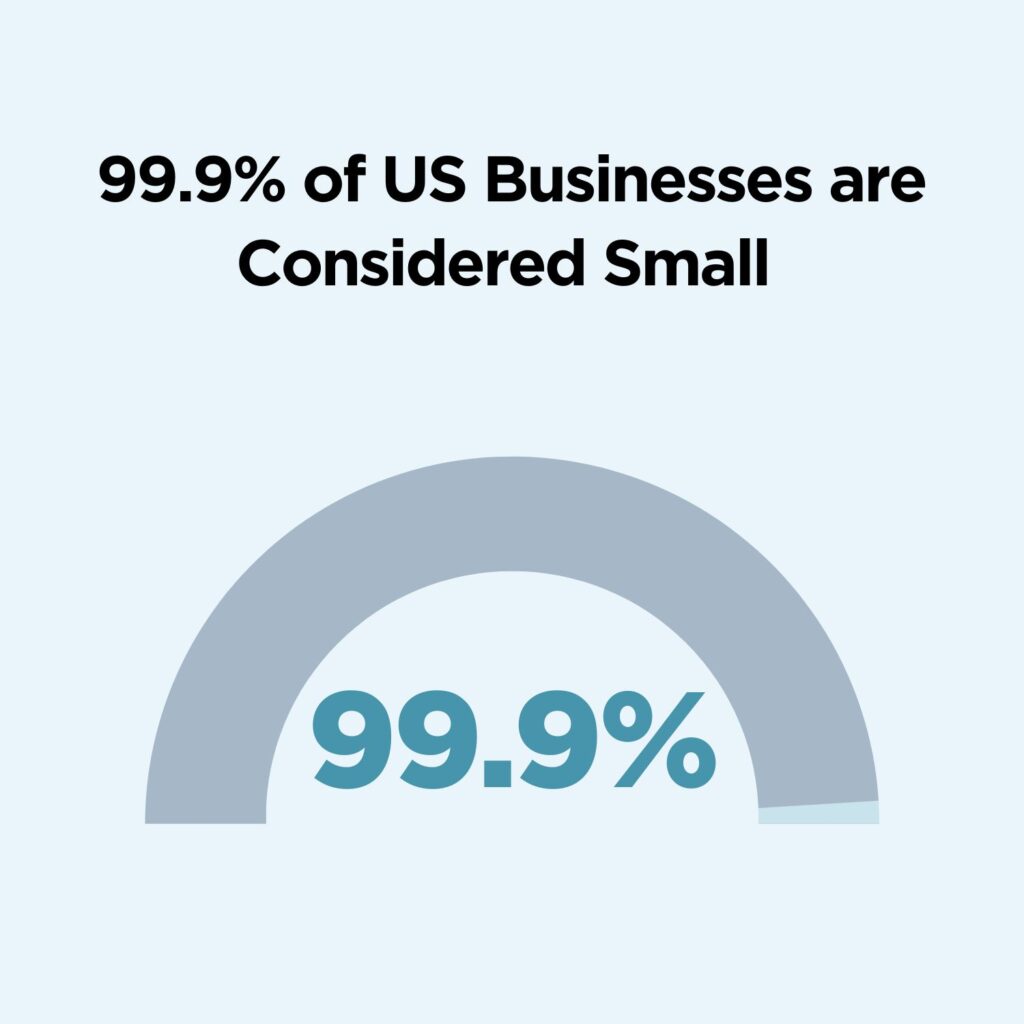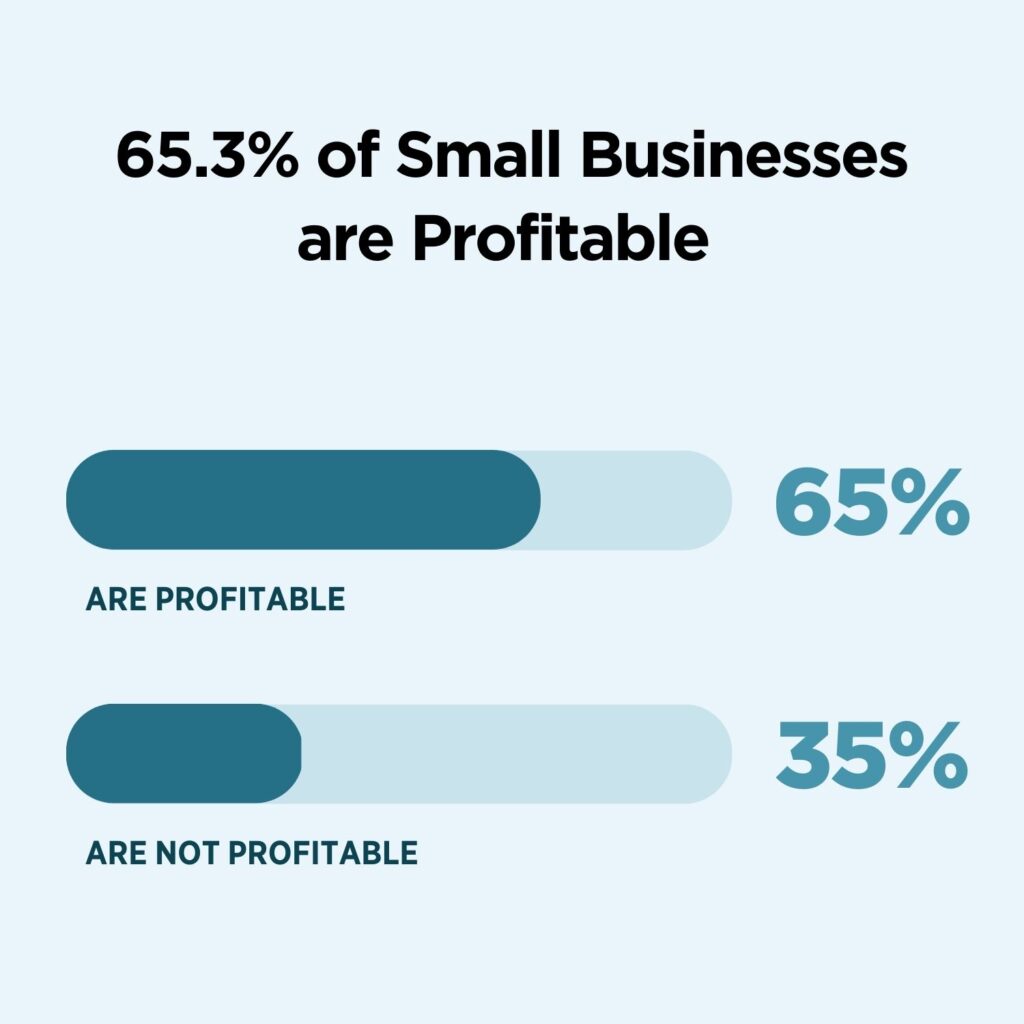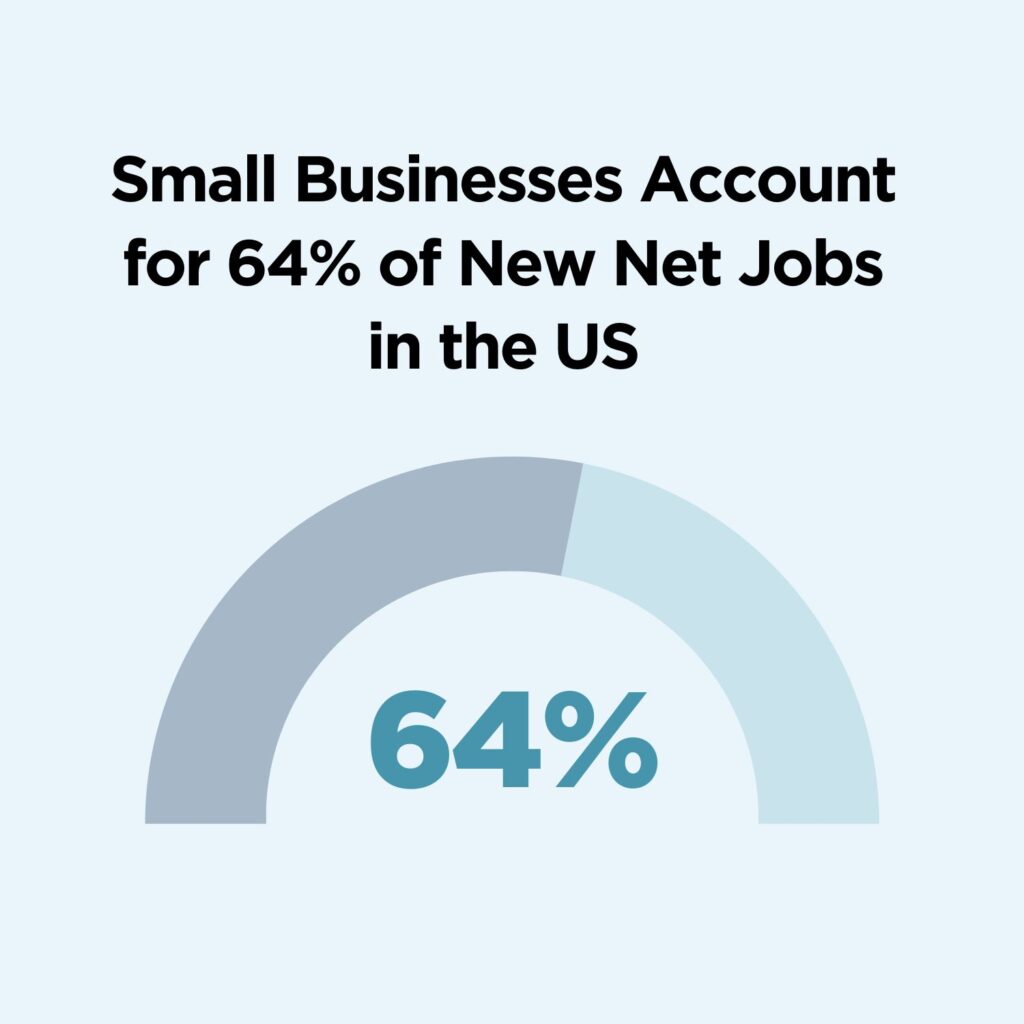It feels like everyone is starting their own small business these days, and that may be more true than you realize. If you’re curious about small business statistics, this is the ultimate list.
To reveal true facts about small businesses, we did the research for you. This list will share top statistics and shed light on the state of the industry in both the United States and on a global scale. It will uncover how successful small businesses actually are, expose their failure rates, reveal their demographics, and so much more.
Ready to learn what a big deal small businesses are? Let’s dive in.
Overview of the top small business statistics in 2024
- There are 33.3 million small businesses in the US
- Small businesses account for 64% of new jobs annually and every year, they create 1.5 million jobs in the US
- 99.9% of businesses in the US are small businesses (businesses with fewer than 250 employees)
- 60% are starting a business to be their own boss
- 50% of small businesses fail in the first five years
- Over 65% of small businesses are profitable
- 64% of small businesses start their businesses with $10,000
- Globally, 90% of all companies are small businesses and they account for 50% of jobs
- There are 400 million small businesses in the world
What is a small business?
According to the United States Census Bureau, the majority of U.S. businesses have fewer than five employees. So, do these classify as “small businesses”? Well, sort of.
A small business is defined by the firm’s size (number of employees) and/or its annual revenue. These definitions depend on the business industry and change from one to the next. Firm revenue caps can range from $1M to $40M, while employee top counts can range from 100 to over 1,500. These standards are decided upon by the U.S. Small Business Administration or SBA.
The SBA has a Table of Small Business Size Standards that lists all of these factors per industry, setting guidelines for businesses nationwide. For example, soybean farmers can make up to $2M per year, while retail bakeries must have under 500 employees to be considered a small business.
Regardless of these American specificities, worldwide, many simply consider small businesses to be those with less than 250 people.
Whether a business has 15 employees or 750, small businesses are an essential piece of the global economy and are a primary driver of U.S. financial growth. It is a lot of work to run a small business, but there are some unique benefits to it.
Are there benefits to being a small business?
Absolutely. A business’ size definition directly influences how much federal assistance it can receive. Some key benefits that small businesses can take advantage of include:
- Small Business Loans: The SBA can act as a co-signer for small businesses seeking loans. Other banks can grant small business loans too, some with lower interest rates.
- Government Contracts: These federal contracts help small businesses compete with larger competitors.
- Grants: Small businesses are eligible for many grants to help fuel research and innovation. Grants don’t need to be paid back, so it provides powerful capital.
- Adaptable: Fewer employees mean fewer internal processes, allowing small businesses to adapt as necessary and better cater to customers’ needs.
- Special: People want to support small businesses. They are unique and have the potential to offer more intimate experiences than big brands.
- Happiness: 74.86% of small business owners are happy.
Now that you know more about small businesses and what sets them apart by definition, it’s time to see the facts. Let’s kick off our list of small business statistics.
How many small businesses are there?
1. There are 33.3 million small businesses within the United States
(SBA 2023 Small Business Profile)
As of 2023, the SBA reported 33,185,550 small businesses within the United States. Hundreds of thousands of small businesses both open and close annually, but it has maintained a net increase over the past couple of years.

2. 99.9% of businesses in the US are small businesses
(SBA 2023 Small Business Profile)
Only .01% of businesses within America are not considered small businesses. Of the majority, 98% have fewer than 100 employees and 89% have fewer than 20 workers. These small businesses give jobs to more than 61.2M Americans. This accounts for 46.8% of the total workers nationwide.

3. The number of U.S. small businesses has doubled since 1982
(Semrush)
In just 3 decades, the amount of small businesses operating in America has doubled. These small businesses are even expanding into commercial properties. 30-50% of all commercial space, estimated to be around 20-34 billion square feet, is occupied by American small businesses.
4. Small businesses generate 44% of U.S. economic activity (GDP)
(SBA Press Release)
America’s gross domestic product, GDP, is the market value of the goods and services produced by businesses (employees and property) inside the country. In 1998, small businesses generated almost half (48%) of the GDP. Fast forward to 2014 and this statistic decreased to 43.5%. Regardless, the government considers small businesses vital because they are at the forefront of driving innovation, providing jobs, and generating economic growth.
5. Small businesses are responsible for 2 out of every 3 jobs created in the past 25 years
(SBA Small Business Facts Report)
In the past quarter of a century, large businesses created over 6.7 million new net jobs. Meanwhile, small businesses generated 12.9 million new net jobs during the same period. Employment growth has been fueled by small businesses making up 66% of all new jobs over the past 25 years.
What is the success rate for small businesses?
6. 65.3% of small businesses are profitable
(Guidant Financial & Small Biz Genius)
Right now, over 65% of small businesses operating were profitable in 2022. This is exciting news since a 2018 study showed just 40% of small businesses were profitable. Meanwhile, 35% of small businesses are not profitable.

7. 9% of small businesses make over $1 million
(Small Biz Genius)
In 2018, almost one out of 10 small businesses reportedly made over $1 million per year. It’s likely that this number is higher today. There are 16% of owners less successful, making less than $10,000 per year. If you were to start a small business now, the most lucrative industries are technology, health, and energy.
8. 77% of small businesses feel optimistic about the future of their business
(US Chamber of Commerce)
According to a poll taken in October of 2021, more than three in four small business owners are optimistic about the future. The same poll revealed that 38% plan to hire more workers and 42% plan to increase investments into their businesses. Both of those statistics are significant increases from 2020.
9. The industry with the highest small business survival rate is healthcare and social assistance
(Small Business Funding)
Small businesses related to healthcare and social assistance have an 85% chance of surviving their first year. By year five, 60% will survive. The industry with the lowest first-year survival rate is the transportation industry where only 75% survive their first year. By year five in this industry, only 30% of transportation businesses are still around.
10. 62% of small businesses say that their business is in “good health”
(US Chamber of Commerce)
Over 60% of owners consider their business successful and in “good health.” The next step, “very good health,” was the response of an impressive 30% of small businesses. The U.S. Chamber of Commerce’s poll proved that small business owners’ optimism about succeeding is high, despite current economic struggles like inflation, labor shortages, and supply chain problems.
How many small businesses fail?
11. 20% of small businesses fail within the first year
(Fundera)
The U.S. Bureau of Labor Statistics reports that about 80% of small businesses will survive their first year. About 70% of businesses with employees will survive their second year in business. Down the road, it’s reported that 70% of small business owners will fail before their 10th year of operating.
12. Over half of all small businesses fail in the first five years
(Fundera)
Over 50% of small businesses will fail before their fifth consecutive year of operating. Only 30% go on to survive their 10th year in business. According to trends by the U.S. Bureau of Statistics, these failure rates have remained consistent for decades.
| Years in business | Failure rate |
| 1 | 20% |
| 2 | 30% |
| 5 | 50% |
| 10 | 70% |
13. 82% of small businesses fail because of cash flow issues
(Small Biz Genius & Fundera)
Cash flow is one of the biggest problems for small businesses. 29% fail simply because they run out of cash. A 2015 study showed that 27% of owners were not able to access the capital needed to continue operating their business. Many small businesses consider cash flow to be their biggest challenge.
14. 42% of small businesses fail due to a lack of demand
(Fundera)
Apparently, small businesses need to conduct deeper market research prior to starting. Why? Over 40% of them fail because there is no market need for their products or services. 19% say failure was due to being “outcompeted” while 17% say it was because of their poor product offering. This lack of market demand could also be the 14% of small businesses that fail because of poor marketing.
15. 23% of small businesses fail because they don’t have the right team
(Fundera)
Almost one-quarter of failed small businesses attribute their demise to their teams. 23% say their business failed due to a lack of having the “right” team. Another 17% failed because they lacked a business model and 14% ignored their customers.
| Reason | Percentage |
| Cash flow issues | 82% |
| Lack of demand | 42% |
| Lack of talent | 23% |
| Lack of business model | 17% |
| Ignored their customers | 14% |
| Poor marketing | 14% |
16. 46% are unsure whether their marketing strategies are working
(Keap)
Almost half of the small businesses marketing themselves are unsure whether their efforts are even working. 17% know they are not working. This supports the idea that marketing, especially digital marketing, is elusive to small businesses. Many owners reported their greatest challenge is getting a break from their business long enough to attempt marketing.
17. 66% of small businesses face financial challenges
(Semrush)
It’s quite common for small businesses to undergo financial challenges. What’s the most prominent financial struggle? 43% say that paying operating expenses is the toughest thing they face. The average cost of launching a retail business is $32,000, and store owners have reported they started with only $5,000 saved.
Small business revenue statistics
18. 27% estimated their 2020 annual sales would exceed $200,000
(Zen Business)
Under 30% of owners predicted their sales to exceed $200,000 two years ago. Meanwhile, 43% of businesses operating full-time estimated their sales would be under $50,000 that same year. These sales statistics were affected by the pandemic since before it in 2018, only 37% were estimated to make less than $50,000, and 32% predicted sales over $200,000.
19. The average annual sales for non-employers was $46,978
(Zen Business)
Non-employer small businesses, so those who operate them on their own, make a modest revenue. A 2017 report showed that the average non-employer had receipts making up less than $47,000. Another study found that 45% of these non-employers had revenues of less than $25,000 a year.
20. Over 86% of owners take a yearly salary of less than $100,000
(Fundera)
According to one study, the majority of small business owners (86.3%) pay themselves less than six figures. This is surprising considering the national median salary for CEOs is around $158,000. So, it can be concluded that owners take less than they likely would in other scenarios, perhaps to reinvest into the business, hire more staff and expand opportunities for the welfare of their business. 30.07% of small business owners don’t even take a salary!
21. 64% of businesses begin with $10,000 in capital
(Small Biz Genius)
Small business statistics found that the average amount necessary to get a business off the ground is $10,000. Micro businesses, however, can get started with as little as $3,000. Furthermore, an estimated quarter of small businesses begin with no financing at all!
22. 65% of entrepreneurs don’t think they have enough cash to start a business
(Kabbage)
A poll based on 600 thriving U.S. small businesses revealed that 65% of them were not fully confident that they had enough money to start. The majority of them (93%) predicted a run rate shorter than 18 months. Regardless of lacking the cash up front, 82% of respondents said they felt that they possessed the right qualifications and experience to successfully launch and operate their small business.
23. One-third of successful small businesses started with less than $5,000
(Kabbage)
From the same Kabbage poll mentioned above, 58% said they started with less than $25,000. One-third of them needed just $5,000 to launch. The three categories of small businesses that required the least amount of startup capital were accounting, online retail, and landscaping.
24.41% of local businesses depend on social media to drive revenue
(Fundera)
Over 40% don’t just use social media, but depend on it for revenue. The overwhelming majority of 96% of small businesses claim to use social media within their marketing strategy. That’s because 74% of consumers rely on social media to guide their purchasing decisions. In short, social media matters to small businesses—and to consumers!
U.S. small business statistics
25. Small businesses account for 64% of the new net jobs created every year in the United States
(Office of Advocacy, SBA)
From 2000 to 2019, U.S. small businesses created 10.5 million net new jobs while large businesses only create 5.6 million. Reports show that small businesses are generating 1.5 million jobs every year. Small businesses’ startup employment averages 4.4 employees, making up 59 million jobs overall.

26. One in three small businesses are family owned
(Office of Advocacy, SBA)
Small businesses are a family thing, at least they are for 31% of those in America. Family-owned businesses average 14 employees per firm. This average is bigger when compared to non-family-owner employer firms, which average 10 employees. American industries with the most family-owned businesses include agriculture (46%) and management of services (46%). The industry with the fewest family-owned firms was healthcare and social assistance (18%).
27. 17.7% of U.S. small businesses are owned by minorities
(Office of Advocacy, SBA)
This percentage totals about 1 million businesses nationwide. Of employer firms, 5.6% were Hispanic-owned, 2.2% were African-American-owned, 9.7% Asian-owned, and 0.5% were owned by other minorities like American Indians, Alaskan Natives, Native Hawaiians, and Pacific Islanders. 6.1% of U.S. employer firms were owned by veterans.
| Ethnicity | Percentage |
| Asian | 9.7% |
| Hispanic | 5.6% |
| African-American | 2.2% |
| Other minorities | 0.5% |
28. Women own 41% of all non-employer U.S. small businesses
(Office of Advocacy, SBA)
That means American women own approximately 10.1 million non-employer small businesses. As for small businesses with employees, women only represent 20% of those employers. Women business owners with employees make up 1.1 million U.S. businesses.
29. 40.6% of American small business owners are Republicans
(Guidant Financial)
When it comes to U.S. political parties, 4 out of 10 small business owners consider themselves Republican. 21.9% are Democrats while just 5.4% are Libertarian. Meanwhile, almost 32% consider themselves “unaffiliated” with any American political party.
30. Over 15 million Americans work full-time for their own businesses
(Semrush)
There are 582 million entrepreneurs in the world and 15 million of them are in America working full-time on their own businesses. Of these hustlers who made their business their full-time gig, 38% say that “discipline” is needed to have an entrepreneurial mindset.
31. 19% of small business owners work over 60 hours a week
(Fundera)
More than 70% of owners say they work more than 40 hours per week. 81% of business owners work nights and 89% work over the weekends. However, not everyone is working overtime. Most small business owners report working between 40-49 hours per week. The national average is 38.6 hours per week.
32. 60% are starting a business to be their own boss
(Guidant Financial)
People launch small businesses for countless reasons, but one of the major motivations is to become their own boss. Over 47% had an overall dissatisfaction with corporate America. Other reasons to start a small business included pursuing their passion (31%), because an opportunity presented itself (21%) and because they were newly unemployed (23%). Almost 23% of small business owners were just “not ready to retire!”
| Reason | Percentage |
| Be their own boss | 60% |
| Dissatisfaction in corporate life | 47% |
| Passion | 31% |
| Opportunity | 21% |
| Unemployment | 23% |
| Not ready to retire | 23% |
33. 16.3% of self-employed Americans are over 65
(Office of Advocacy, SBA)
It turns out that small businesses are keeping people out of retirement. Over 16% of self-employed Americans over the retirement age of 65 continue working. In comparison to the opposite side of the age gap, self-employed Americans aged 30 or younger only make up 7.4% of self-employed workers.
Global small business statistics
34. Small businesses account for around 90% of businesses globally
(World Bank)
SMEs, or small and medium enterprises, are responsible for 90% of the world’s businesses, and more than 50% of employment worldwide. Formal SMEs also create 7 out of 10 jobs. SMEs contribute around 40% of the national income (GDP) in emerging companies, too.
35. There are around 400 million small businesses worldwide
(National Action Plans on Business and Human Rights)
It’s approximated that there are currently over 400 million SMEs worldwide. It’s understood that these small and medium-sized enterprises are the backbones of economies around the world, generating the largest share of new jobs and representing 99% of all businesses.
36. 600 million jobs need to be created by 2030 to support the growing global workforce
(World Bank)
As our world’s population grows, so does our need to create more jobs. Per World Bank’s estimates, we’ll need 600 million more jobs in less than 10 years to absorb the new workforce. This is why small business and SME development is a core focus for governments worldwide.
37. SMEs are less likely to be able to obtain bank loans than larger firms
(World Bank)
This statement is true globally and within the United States, too. It’s simply more difficult for small businesses to get access to bank loans or raise capital. The International Finance Corporation (IFC) estimates that 65 million firms (40%) in developing countries have unmet finance needs.
38. 56% of owners report that digitalization is too expensive for SMEs
(McKinsey)
According to a McKinsey study in Singapore, over half of the survey respondents said that digitalization is too expensive for small businesses. Small businesses are less digitalized than medium-sized and naturally, large enterprises are the most advanced digitally. There is a multitude of reasons for this, but one large factor is that digital solutions are typically designed for large companies and are too complex to scale down to the SME level. Another reason is explained by the small business statistic that 40% of owners (in Singapore) claim they lack the digital skills to successfully adopt new technologies.
39. 70-80% of SMEs worldwide lost between 30-50% of their revenues during COVID-19
(McKinsey)
Between February 2020 and April 2021, during the midst of the COVID-19 pandemic, it’s estimated that up to 80% of small to medium-sized businesses lost up to 50% of their revenues. This data is based on SMEs from 32 different countries, proving that the pandemic dramatically affected businesses on a global scale. In a U.S.-based 2020 study, 45% of small businesses experienced disruptions within their supply chain.
General small business statistics
40. 92% of owners believe a website is the most effective digital marketing strategy
(Fundera)
Despite the overwhelming majority, there are still 11% of small businesses that don’t see the value in having a website. Almost half (47%) of businesses spend less than $10,000 on digital marketing per year. On the flip side, 1 in 5 doesn’t use digital marketing and 1 in 10 doesn’t invest in any form of marketing whatsoever.
41. 31% of owners see sales as their top marketing goal
(Keap)
Driving sales is the top marketing goal for 30.8% of small business owners. One quarter (25%) say that retaining and re-engaging customers is their top priority. Other important priorities include building brand awareness (17%), collecting leads (8%), and cost savings (8%).
42. 47% of owners run marketing entirely on their own
(Fundera)
Small business owners wear many hats, especially when you factor in that nearly half of them are in charge of their marketing. That explains why per week, almost half of the small businesses spend less than two hours on it.
43. 50% of small businesses are operated from home
(Office of Advocacy, SBA)
About half of small businesses are operated right out of the owners’ homes, both employer and non-employer firms. Only 24% of employer firms were home-based. The age of the business directly relates to whether they are operated at home or not. 32% of employer firms two years or younger operate from home. This percentage nearly halves (17%) for firms over 16 years old.
44. 91% of consumers support small businesses when it’s convenient
(Semrush)
Consumers want to support small businesses! A significant 91% of customers choose to work with small businesses when it is convenient. Two-thirds of consumers (74%) look for ways to support small businesses even when it is not convenient. 77% are even willing to pay more if they receive excellent customer service.
45. 28% of data breaches involve small businesses
(Semrush)
In 2020, almost 3 out of 10 data breaches involved small businesses. It’s not that surprising, considering 80% of small businesses are not taking full advantage of available technology. This lack of technology adoption could trickle into cyber security and general technology know-how.
46. 65% are more likely to invest in technology like AI
(Semrush)
A large portion of small businesses expressed interest in investing in artificial intelligence for automation. AI is making automation easier, especially through online and digital channels. No touch payments, like contactless cards and mobile payments, increased over 2020.
47. 39% of small business owners are “very happy”
(Guidant Financial)
Nearly one in four small business owners consider themselves “very happy” while another 36% are “somewhat happy.” These percentages far outweigh the negative side of the emotional spectrum where 10% are “somewhat unhappy” and just 4.5% are “very unhappy.” About 10% felt neutral.
48. 92% of small business owners don’t regret starting their business
(Fundera)
In the end, more than 9 in 10 owners don’t regret starting their business. Why? Those savvy and ambitious enough to start their own businesses know what comes with the territory. Although they may work overtime and be burden with the stresses of keeping the lights on, small businesses are creating jobs, supporting communities, and making a difference in every country worldwide.
Frequently asked questions (FAQ)
What percent of businesses are small?
Globally, 90% of businesses are small and account for 50% of jobs. In the US, 99.9% of businesses are small. 98% have fewer than 100 employees and 89% have fewer than 20 employees, with small business jobs accounting for 46.8% of jobs in the US. Small businesses employ 61.2 million Americans.
What percentage of small businesses are profitable?
According to the latest stats, 65% of small businesses are profitable. That’s a bug jump from 2018, when 40% reported being profitable.
Over to you!
That’s all! You just sifted through all the top small business statistics.
Small businesses are growing…and as more and more people are turning to online businesses, so is their profitability.
Want to learn how to run your own business? Here’s the ultimate guide.
Further reading:
The Best Online Business Models
Benefits of an Online Business
Sources
SBA 2023 Small Business Profile
National Action Plans on Business and Human Rights








